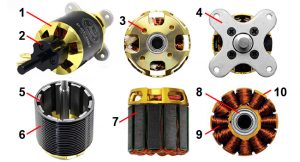Brushless motors use a standard numbering scheme to describe their physical size and kV rating. For example: let’s assume we have a 5055-3000kV Brushless Outrunner Motor from Scorpion for example. We break the numbers out as follows: [50] [55] – [3000]
- [50] The first two numbers represent the diameter of the motor’s housing in millimeters; in this example 50mm
- [55] The second two numbers represent the length of the motor housing in millimeters; in this example 55mm
- [3000] The numbers after the dash represent the kV rating of the motor; in this example 3000kV.
Other brands like Kontronik use 800 / 1000 serie numbers like the Pyro 800-48
- Pyro repesents the engine familie
- [800] Represents the size
- [48] Is the numbert of kV rating devided by 10. In this case 480kV
The kV rating (not to be confused with kilo-volt) is the RPM of the motor (k) per volt (V) with no load. For example, a brushless motor with a kV rating of 3000 powered by a 12V power source would be capable of 36,000 RPMs (multiply 3000×12). This is the max RPMs that this motor can reach under no load. A motor with a higher kV will have more top end speed, but not as much acceleration/torque. A motor with a lower kV will not be as fast, but will accelerate faster and have more torque.

- Machined aluminum front housing with multi angled cooling holes.
- Threaded prop adapter.
- Rear threaded mounting holes.
- An aluminum cross style mount.
- NdFeB magnets.
- Durable black Electro-Coat finish on the flux ring to look good for years to come.
- Sstator plates.
- Shielded ball bearings are used to support the motor shaft in all our motors.
- High Temperature 180 C (356 F) rated wire is used for winding the motors to minimize the risk of burning up the motor.
- High temperature adhesives are used to secure the stator windings and prevent them from shifting and getting pinched or shorting out .
